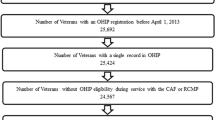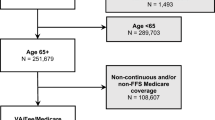Abstract
OBJECTIVE
To determine if the combined effects of patient-level (demographic and clinical characteristics) and organizational-level (structure and strategies to improve access) factors are uniformly associated with utilization of Indian Health Service (IHS) and/or Veterans Health Administration (VHA) by American Indian and Alaska Native (AIAN) Veterans to inform policy which promotes dual use.
METHODS
We estimated correlates and compared two separate multilevel logistic regression models of VHA-IHS dual versus IHS-only and VHA-IHS dual versus VHA-only in a sample of 18,892 AIAN Veterans receiving care at 201 VHA and IHS facilities during FY02 and FY03. Demographic, diagnostic, eligibility, and utilization data were drawn from administrative records. A survey of VHA and IHS facilities defined availability of services and strategies to enhance access to healthcare for AIAN Veterans.
RESULTS
Facility level strategies that are generally associated with enhancing access to healthcare (e.g., population-based services and programs, transportation or co-location) were not significant factors associated with dual use. In both models the common variable of dual use was related to medical need, defined as the number of diagnoses per patient. Other significant demographic, medical need and organizational factors operated in opposing manners. For instance, age increased the likelihood of dual use versus IHS-only but decreased the likelihood of dual use versus VHA-only.
CONCLUSIONS
Efforts to enhance access through population-based and consumer-driven strategies may add value but be less important to utilization than availability of healthcare resources needed by this population. Sharing health records and co-management strategies would improve quality of care while policies allow and promote dual use.

Similar content being viewed by others
REFERENCES
Kramer BJ, Wang M, Jouldjian S, Lee ML, Finke B, Saliba D. Veterans Health Administration and Indian Health Service: Healthcare utilization by Indian Health Service enrollees. Med Care. 2009;47(6):670–6.
Kramer BJ, Jouldjian S, Finke B, Saliba D, Yano EM, Mitchell M, Dang, J. VHA and Indian Health Service: Access for American Indian Veterans: Survey of VHA and IHS Facilities’ Leadership. Sepulveda, CA: VA Greater Los Angeles HSR&D Center of Excellence (Technical Report #VHA-IHS07_002), 2007. Available upon request.
Borowsky SJ, Cowper DC. VA resource allocation based on # of Vets in each VISN. Neither allocation of resources not quality measures account for those Vets who receive care from non-VA. Dual use of VA and non-VA primary care. J Gen Intern Med. 1999;14(5):274–80.
Couper DC, Manheim LM, Weaver FM, Pawlow AJ. Mix and match: VA and non-VA care for elderly veterans. VA Practioner 1993:41–4.
Cunningham PJ, Altman BM. The use of ambulatory health care services by American Indians with disabilities. Med Care. 1993;31:606–16.
Gurley D, Novins DK, Jones MC, et al. Comparative use of biomedical and traditional healing options by American Indian veterans. Psychiatr Serv. 2001;52:68–74.
Harada ND, Villa VM, Reifel N, Bayhylle R. Exploring veteran identity and health services use among Native American veterans. Mil Med. 2005;170:782–6.
Washington DL, Yano EM, Simon B, Sun S. To use or not to use. What influences why women veterans choose VA health care. J Gen Intern Med. 2006;21(Suppl 3):S11–8.
Selim AJ, Kazis LE, Qian S, Rothendler JA, Spiro A 3rd, Rogers W, Haffer SC, Wright SM, Miller D, Selim BJ, Fincke BG. Differences in risk-adjusted mortality between Medicaid-eligible patients enrolled in Medicare advantage plans and those enrolled in the veterans health administration. J Ambul Care Manage. 2009;32(3):232–40.
Jha AK, Perlin JB, Kizer KW, Dudley RA. Effect of the transformation of the Veterans Affairs health care system on the quality of care. N Engl J Med. 2003;348(22):2218–27.
Kunitz SJ. The history and politics of US health care policy for American Indian and Alaska natives. Am J Public Health. 1996;86(10):1464–73.
US Department of Veterans Affairs. Eligibility for health benefits. Available at: http://www.va.gov/healtheligibility/. Accessed May 9, 2011.
US Department of Health and Human Services, Indian Health Service. IHS Fact Sheets. Available at: http://info.ihs.gov/TrblSlfGov.asp. Accessed October 5, 2009.
Cunningham PJ. Access to care in the Indian Health Service. Health Aff. 1993;12:224–33.
Kramer BJ, Vivrette RL, Satter DE, Jouldjian S, McDonald LR. Dual use of Veterans Health Administration and Indian Health Service: healthcare provider and patient perspectives. J Gen Intern Med. 2009;24(6):758–64.
Kramer BJ, Sarkisyan S, Yano E, Washington D, Harker JO. Dual use of VHA and IHS healthcare by women. Women’s Health Issues. 2009;19(2):135–43.
Fortney JC, Booth BM, Bosworth HB, Kaboli P, Burgess J. A re-conceptualization of access for 21st century healthcare. Paper commissioned for the September 2010 VA State of the Art Conference on Access, Arlington, VA.
US Department of Agriculture, Economic Research Service. Measuring Rurality: Rural-Urban continuum codes. Available at: http://www.ers.usda.gov/Briefing/Rurality/RuralUrbCon/. Accessed June 14, 2011.
Ashton CM, Petersen NJ, Wray NP, Yu H. The Veterans Affairs medical care system: Hospital and clinic utilization statistics for 1994. Med Care. 1997;36:793–803.
USDHHS, PHS, Indian Health Service Office of Planning, Evaluation and Legislation, Division of Program Statistics. Regional differences in Indian health. 1993.
Kramer BJ, Wang M, Hoang T, Harker JO, Finke B, Saliba D. Identification of American Indian and Alaska Native Veterans in administrative data of the Veterans Health Administration and the Indian Health Service. Am J Pub Health. 2006;96(9):1577–8.
Institute of Medicine, Committee on Enhancing Healthcare Quality Programs. Leadership by example: Coordinating government roles in improving health care quality. JM Corrigan & BM Smith, Eds, Washington DC: National Academy Press, 2002.
Kramer BJ, Finke B, Saliba D, Jouldjian S, Yano EM. Fostering closer alignment of the Veterans Health Administration and the Indian Health Service. Mil Med. 2010;175(7):463–5.
Acknowledgements
This research was supported by a grant from the VA Health Services Research and Development, ACC 03–304. This report presents findings and conclusions of the authors; it does not necessarily reflect the opinions or policies of the Department of Veterans Affairs or the Indian Health Service. An earlier version of this paper was presented in a paper session at the Gerontological Society of America, annual scientific meetings in New Orleans, November 2010.
Conflict of Interest
None disclosed.
Institutional Review Board
The project was reviewed and approved by the VA Greater Los Angeles Healthcare System Institutional Review Board, the national Indian Health Service and Tribal Institutional Review Boards as required.
Author information
Authors and Affiliations
Corresponding author
Rights and permissions
About this article
Cite this article
Kramer, B.J., Jouldjian, S., Wang, M. et al. Do Correlates of Dual Use by American Indian and Alaska Native Veterans Operate Uniformly Across the Veterans Health Administration and the Indian Health Service?. J GEN INTERN MED 26 (Suppl 2), 662 (2011). https://doi.org/10.1007/s11606-011-1834-2
Published:
DOI: https://doi.org/10.1007/s11606-011-1834-2




